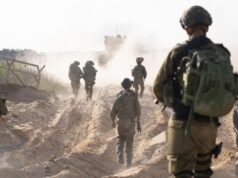
After 9/11, Americans learned a lot about the Arab/Muslim world: the divide between Sunnis and Shiites; secular and religious – including the secular anti-Assad rebels and the religious jihadists in Syria; Arabs and Persians; and nationalists and pan-Arabs.
- We learned that President Bush created ISIS by invading Iraq and that President Obama created ISIS by leaving Iraq.
- We learned there are countries that support Islamic terror and countries that fight it – Iran and Saudi Arabia, both religious, being the former and Saddam Hussein’s secular Iraq and Bashar Assad’s secular Syria being the latter.
- We learned that a lot of this is America’s fault and some of it has to do with Palestinians.
So much of what we “learned” is wrong.
In ISIS: Inside the Army of Terror, Michael Weiss and Hassan Hassan describe jihadist organizations as being like the mafia, with connections in other terrorist organizations as well as to banking, industry, and the military in various countries – “Rolodex pragmatism,” it is called. They enrich themselves through legal and extralegal means, and attract followers by appealing to their interests and by threatening their lives. The long-term relationship between corrupt regimes – Iran figures heavily here – and jihadist forces is at the core of much of today’s carnage in Syria and Iraq.
Weiss and Hassan begin at the beginning of al-Qaeda and its links with Iran. From this ISIS emerges – ISIS isn’t a separate entity, but an odd mash up of al-Qaeda and the Baath Party. They set the first 100 pages in Iraq, an opportunity to discuss the successes and failures of American policy there, but also an introduction to streams of Islamic and Arab political thinking, and tribal politics that have nothing to do with the United States. They move on to Syria and then back to Iraq.
In well-written prose, including interviews with scores of experts – from American soldiers and intelligence officers who served in the region to Syrian, Iraqi and Iranian defectors, to academics and politicians from the U.S. and abroad – Weiss and Hassan make you rethink your assumptions and wistfully ask, “What if we’d known this then?”
The book is full of individual bits of information (did you know Bin Laden’s mother was a Syrian Alawite Shiite?), many of them new, but the overarching theme into which the bits are placed is that of minority/majority warfare – not secular vs. religious warfare. Saddam Hussein was a Sunni minority dictator fighting to hold back what he believed was a Shiite tide supported by Shiite Iran intent on swamping his boat. That makes the Iran-Iraq war clearer as well.
Bashar Assad is a secular Shiite minority dictator fighting to hold back what he believes is a majority Sunni regional tide – hence his alliance with religious Shiite Iran and Hezbollah.
ISIS plants its flag on the territory of both in a transnational statement.
Al-Qaeda rose with direct military and political assistance from Iran, even as Abu Musab al-Zarkawi (a Jordanian Sunni) was perched in the mountains of Northern Iraq, planning to make an Islamic vassal out of Kurdish territory before heading to Baghdad to oust Saddam. Anticipating an American invasion, in 2002, Bin Laden told al-Zarkawi that the “socialist infidels” of Saddam’s regime were “worthy accomplices in any fight against the Americans. In attacking “the ‘far enemy’ (Americans) jihadists were encouraged to collaborate with the remnants of a ‘near enemy’.”
Iraq
Saddam did not believe the Americans would invade, but he feared the uprising of Iraq’s majority Shiite population – President Bush (41) had already encouraged one such an uprising in 1991 and Saddam feared Iran would foment another. In preparation, according to Michael Gordon and Gen. Bernard Trainor, before the first American soldier arrived in Iraq:
Networks of safe houses and arms caches for paramilitary forces, including materials for making improvised explosives, were also established throughout the country… It was, in effect, a counterinsurgency strategy to fend off what Saddam saw as the most serious threats to his rule. Iraqi Shiites.
But in 2003, Paul Bremer, in the name of the United States government, summarily fired 65-95,000 Iraqi soldiers. Tens of thousands of angry, paycheck-less, humiliated soldiers, believing Shiite majority rule would take revenge on Baathist forces, went straight into the arms of al-Qaeda, the organization best able to a) protect Sunnis, b) fight Shiites, and c) take revenge on the Americans. They brought their counterinsurgency network with them.
Iraq’s Sunnis soon had two enemies – Shiites and al-Qaeda, which proved to be very unpopular in relatively secular Western Iraq. The U.S.-backed surge gave local Iraqis an opportunity to oust al-Qaeda (and some Baathists a chance to switch sides again) while the Americans separated Sunni and Shia populations and tamped down Shiite attacks on Sunni areas. Relative peace plus a series of local and national elections helped put Iraq on fairly stable footing, despite American support for the Shiite Prime Minister and his increasingly anti-Sunni behavior. Then we left.
The bad guys didn’t.
Syria
The extent to which Bashar Assad cooperated with jihadist forces is not well understood in the U.S., where he is condemned for his methods but generally thought to be fighting Islamist radicalism with his secular state. But much like Saddam, Assad was protecting a minority government. A former Syrian diplomat told Weiss and Hassan:
Assad understood that part of Bush’s strategy in Iraq was to end minority rule of Sunnis ruling over majority Shiite. He feared that he would be next. From then on, he started to work with mujahidin; he did everything possible to convince the Americans, “Don’t come after me, otherwise I’ll send more terrorists next door to kill your soldiers.”
Occasional cooperation between the U.S. and Assad on capturing terrorists was part of Assad’s way of becoming “the indispensible man.” On the other hand, al Qaeda was tolerated as long as it’s terrorism was committed outside Syria.
In 2010, as the Obama administration was thinking of Assad as a “reformer,” there was a meeting between the State Department’s Coordinator for Counterterrorism and Syria’s Vice Foreign Minister. Assad’s director of general intelligence joined them unexpectedly. He told the American that Syria wanted better relations to “facilitate cooperation against terrorism,” but that “in order to convince the Syrian people… progress must be made on issues related to economic sanctions against Syria including spare parts for airplanes…”
In 2011, the U.S. permitted the export of airplane parts to Syria. In 2013, barrel bombs dropped from airplanes made their debut; in 2014, chlorine gas was dropped from airplanes on Syrian civilian areas.
Foreign Fighters
This is another area in which Westerners are, well, Western-centric. The media tends to highlight British, French and American jihadists, but as Weiss and Hassan note, by December 2014, the CIA calculated 15,000 foreign fighters in Syria, of whom only 2,000 were Westerners. “The predominant emigration trend has always been from the Middle East and North Africa, with Saudi Arabia, Libya, and Tunisia being the highest feeder countries of foreign Sunni militants.”
Native Syrians “tended to enlist with homegrown extremist factions rather than the more foreigner-friendly ISIS.” But “extremist factions” is a term of art. The enormous suffering of the Syrian people under Assad has tended to push anti-regime Syrians toward the radicals rather than toward the “secular” militias.
Those conscious of their own radicalization typically point to the Houla and al-Bayda and similar massacres as the reason for their turn to Islamist and jihadist rebel factions closer to the end of 2012 … ISIS benefited from the Assadist massacres in another respect: for one, the gruesome manner in which they were carried out helped create some level of tolerance for beheadings, which was accepted by many Syrians as retribution against the regime and its Iranian-built militias.
ISIS Rule
In the last chapter, Weiss and Hassan provide a glimpse of how ISIS rules its territory and how local people tolerate it. Non-jihadist Syrian rebels – specifically Free Syrian Army fighters – were known to be corrupt, violent and most important, inefficient, occupiers. ISIS, on the other hand, was not corrupt and managed local affairs competently. Yes, strict Sharia rules – including executions – made people uncomfortable, but that was balanced by having courts, police, and city services. Random attacks on the population ceased.
The combination of brute force and effective governance means that the local population has little motivation and a huge deterrent to rise up against ISIS, particularly in the absence of a viable and acceptable alternative. Such policies also make it much harder for any force from outside to retake these areas from ISIS, owing to the difficulty of filling the void and forming new alliances with the local communities.
The Epilogue
The Epilogue addresses the supreme irony of the U.S. looking to Iran as a partner against ISIS. Not only did Iran help establish Sunni jihad as a player in the region, but it also fuels the fears of Sunni Iraqis, already not wrongly believing the Shiite majority is out for Sunni blood. Now it is being passed off as a partner. Assad and his Russian partners are hoping to make the same case – “après moi, le deluge.” Assad, however, IS the deluge and it is his brutality that to this day drives Syrians to ISIS and assorted jihadist organizations.
The takeaways are the groundwork for establishing American goals in Syria and Iraq. (Not strategies – strategies are the means of achieving the goal.)
- Assad’s brutality is the driving force for jihad in Syria; his removal is essential to any future peace. Assad, Iran, Hezbollah and Russia cannot be our partners.
- ISIS, representing a strain of Sunni Islam (85% of Muslims worldwide; Shiism accounts for a bare 15%), thrives by presenting Sunnis as a persecuted minority, fighting for survival. Shiites provide proof that this is true.
- ISIS isn’t a discrete entity. It is the current incarnation of earlier religiously based organizations, and has swallowed other jihadist groups whole.
- ISIS isn’t only a terrorist organization. “It is a mafia adept at exploiting decades-old transnational gray markets for oil and arms trafficking. It is a conventional military…it is a sophisticated intelligence-gathering apparatus…it is a slick propaganda machine.”
- ISIS leadership is not comprised only of religious fanatics. “Most of its top decision-makers served either in Saddam Hussein’s military or security services. In a sense, then, “secular” Baathism has returned to Iraq under the guise of Islamic fundamentalism – less a contradiction than it may appear.
And finally;
- It’s not all America’s fault. Whatever we did or did not do, the cross currents would look almost the same if we had taken the opposite of each path we did take – except, perhaps, the dismantling of the Iraqi army.
Shoshana Bryen is Senior Director of The Jewish Policy Center and Editor of inFOCUS Quarterly.





